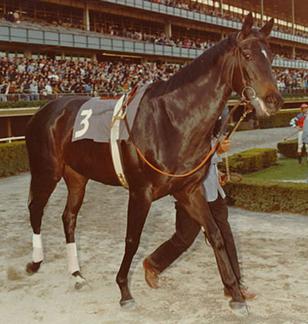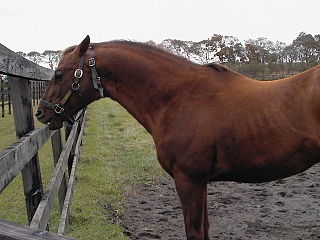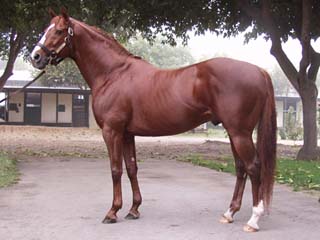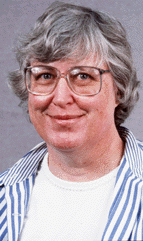Related Research Articles

Orthopedic surgery or orthopedics is the branch of surgery concerned with conditions involving the musculoskeletal system. Orthopedic surgeons use both surgical and nonsurgical means to treat musculoskeletal trauma, spine diseases, sports injuries, degenerative diseases, infections, tumors, and congenital disorders.

Ruffian was an American Thoroughbred racehorse who won ten consecutive races, including the Acorn, Mother Goose and Coaching Club American Oaks, then known as the American Triple Tiara. She was in the lead at every point of call in every race she ever ran and set new stakes records in each of the eight stakes races she won. Her dominating wins caused her to be named the American Champion filly at both ages two and three. In July 1975, she entered a highly anticipated match race with Kentucky Derby winner Foolish Pleasure, in which she broke down. Surgery was attempted but Ruffian reacted poorly and exacerbated the injuries while coming out of anesthesia. As a result, she was euthanized.

Laminitis is a inflammation of laminae that affects the feet of ungulates and is found mostly in horses and cattle. Clinical signs include foot tenderness progressing to inability to walk, increased digital pulses, and increased temperature in the hooves. There is also swelling in foot in some cases.Severe cases with outwardly visible clinical signs are known by the colloquial term founder, and progression of the disease will lead to perforation of the coffin bone through the sole of the hoof or being unable to stand up, requiring euthanasia.
Navicular syndrome, often called navicular disease, is a syndrome of lameness problems in horses. It most commonly describes an inflammation or degeneration of the navicular bone and its surrounding tissues, usually on the front feet. It can lead to significant and even disabling lameness.

Flunixin is a nonsteroidal anti-inflammatory drug (NSAID), analgesic, and antipyretic used in horses, cattle and pigs. It is often formulated as the meglumine salt. In the United States, it is regulated by the U.S. Food and Drug Administration (FDA), and may only be lawfully distributed by order of a licensed veterinarian. There are many trade names for the product.

Cribbing is a form of stereotypy, otherwise known as wind sucking or crib-biting. Cribbing is considered to be an abnormal, compulsive behavior seen in some horses, and is often labelled a stable vice. The major factors that cause cribbing include stress, stable management, genetic and gastrointestinal irritability.
Organ replacement in animals is an emerging field in veterinary science, focusing on improving and prolonging the lives of animals through the replacement or augmentation of damaged or dysfunctional organs. Despite its relative rarity compared to limb prosthesis, strides have been made over the decades, with notable milestones such as the first pacemaker surgery on a dog in 1968 and successful kidney transplants in cats since the mid-1980s. This field faces challenges, particularly in canine programs, due to issues related to immunosuppression. Ethical considerations also exist, particularly concerning the treatment of donor animals, underscoring the need for ongoing discussions and regulations in this dynamic field.

Cerebellar abiotrophy (CA), also called cerebellar cortical abiotrophy (CCA), is a genetic neurological disease in animals, best known to affect certain breeds of horses, dogs and cats. It can also develop in humans. It develops when the neurons known as Purkinje cells, located in the cerebellum of the brain, begin to die off. These cells affect balance and coordination. They have a critical role to play in the brain. The Purkinje layer allows communication between the granular and molecular cortical layers in the cerebellum. Put simply, without Purkinje cells, an animal loses its sense of space and distance, making balance and coordination difficult. People with damage to the cerebellum can experience symptoms like unsteady gait, poor muscle control, and trouble speaking or swallowing.
Exercise-induced pulmonary hemorrhage (EIPH), also known as "bleeding" or a "bleeding attack", is the presence of blood in the airways of the lung in association with exercise. EIPH is common in horses undertaking intense exercise, but it has also been reported in human athletes, racing camels and racing greyhounds. Horses that experience EIPH may also be referred to as "bleeders" or as having "broken a blood vessel". In the majority of cases, EIPH is not apparent unless an endoscopic examination of the airways is performed following exercise. This is distinguished from other forms of bleeding from the nostrils, called epistaxis.
Lameness is an abnormal gait or stance of an animal that is the result of dysfunction of the locomotor system. In the horse, it is most commonly caused by pain, but can be due to neurologic or mechanical dysfunction. Lameness is a common veterinary problem in racehorses, sport horses, and pleasure horses. It is one of the most costly health problems for the equine industry, both monetarily for the cost of diagnosis and treatment, and for the cost of time off resulting in loss-of-use.

Veterinary chiropractic, also known as animal chiropractic, is chiropractic for animals – a type of spinal manipulation. Veterinary chiropractors typically treat horses, racing greyhounds, and pets. Veterinary chiropractic is a controversial method due to a lack of evidence as to the efficacy of chiropractic methods. Contrary to traditional medicine, chiropractic therapies are alternative medicine. There is some degree of risk associated with even skilled manipulation in animals as the potential for injury exists with any technique used. The founder of chiropractic, Daniel David Palmer, used the method on animals, partly to challenge claims that the placebo effect was responsible for favorable results in humans. Chiropractic treatment of large animals dates back to the early 1900s. As of 2019, many states in the US provide statutory or regulatory guidelines for the practice of chiropractic and related treatments on animals, generally requiring some form of veterinary involvement.

The Thoroughbred is a horse breed developed for horse racing. Although the word thoroughbred is sometimes used to refer to any breed of purebred horse, it technically refers only to the Thoroughbred breed. Thoroughbreds are considered "hot-blooded" horses that are known for agility, speed, and spirit.
Racehorse injuries and fatalities are a side effect of the training and competition of horse racing. Racehorse injuries are considered especially difficult to treat, as they frequently result in the death of the horse. A 2005 study by the United States Department of Agriculture found that injuries are the second leading cause of death in horses, second only to old age.
Equine gastric ulcer syndrome (EGUS) is a common cause of colic and decreased performance in horses. Horses form ulcers in the mucosa of the stomach, leading to pain, decreased appetite, weight loss, and behavioral changes. Treatment generally involves reducing acid production of the stomach and dietary management. Unlike some animals, however, stomach rupture is rare, and the main goal of treating is to reduce pain and improve performance of animals used for showing or racing.
The treatment of equine lameness is a complex subject. Lameness in horses has a variety of causes, and treatment must be tailored to the type and degree of injury, as well as the financial capabilities of the owner. Treatment may be applied locally, systemically, or intralesionally, and the strategy for treatment may change as healing progresses. The end goal is to reduce the pain and inflammation associated with injury, to encourage the injured tissue to heal with normal structure and function, and to ultimately return the horse to the highest level of performance possible following recovery.

Ann Trommershausen Bowling was an American scientist who was one of the world's leading geneticists in the study of horses, conducting research in the areas of molecular genetics and cytogenetics. She was a major figure in the development of testing to determine animal parentage, first with blood typing in the 1980s and then DNA testing in the 1990s. She later became known for her studies of hereditary diseases in horses and equine coat color genetics, as well as research on horse evolution and the development of horse breeds. She studied the population genetics of feral horses, did considerable work to help preserve the Przewalski's horse, and was one of the founding members of the international project to map the horse genome. She was an adjunct professor at the University of California, Davis (UCD), and at the time of her death in 2000 was the executive associate director of the Veterinary Genetics Laboratory (VGL) there. Her unexpected death on December 8, 2000, at age 57 was attributed to a massive stroke.

Rood & Riddle Equine Hospital was established in Lexington, Kentucky in 1986 as a partnership between veterinarians William Rood and Thomas Riddle. The facility offers a range of services for the treatment of horses. They have cared for many famous Thoroughbreds both at the racetrack and on the farm. They also provide support for other equine sporting events such as the 2010 FEI World Equestrian Games held in Lexington. Rood & Riddle operates branches in Saratoga Springs, New York and Wellington, Florida.
Simon John Curtis is a farrier, author, lecturer and horse hoof-care expert with a PhD in Equine Physiology and Biomechanics (2017). He is a 4th generation farrier; his family have been farriers and blacksmiths in the Newmarket area for at least 150 years. In over 45 years working as a farrier, he has lectured and demonstrated in more than 30 countries including the USA, Australia, India, Russia, and Brazil.
Alicia L. Bertone is an American academic, administrator, researcher, and veterinary surgeon. She is a professor and a provost in the Office of Academic Affairs at the Ohio State University. Bertone has worked as the Vice-Provost of Graduate Studies, Associate Vice Provost of Data and Analysis, the ENGIE-Axium Endowed Dean of the Graduate School, and the Trueman Family Endowed Chair at the Ohio State University. Bertone is a Professor of Veterinary Clinical Sciences, and, as the Trueman Endowed Chair, established and directed the Comparative Orthopedic Research Laboratory at the University.
Naomi Cogger is an Australian–New Zealand epidemiologist, and is a full professor at Massey University, specialising in the epidemiology of animal diseases that impact animal and human health, and food security.
References
- 1 2 "Veterinary Executive Report" (PDF). vetmed.wsu.edu. Spring–Summer 2010. Retrieved 8 August 2016.
- 1 2 3 4 5 "Merial-NIH National Veterinary Scholars Symposium" (PDF). merial.vet.ohio-state.edu. p. 31. Archived from the original (PDF) on 15 September 2016. Retrieved 9 August 2016.
- 1 2 "Name droppers: UCD equine surgeon earns national honor". The Davis Enterprise. 11 December 2014. Retrieved 8 August 2016.
- 1 2 3 4 "2013 Alumni Achievement Awards". UC Davis School of Veterinary Medicine. Retrieved 8 August 2016.
- ↑ "2014 Founders Award – Stover" (PDF). acvs.org. Retrieved 8 August 2016.
- ↑ "Hall of Fame honor for renowned equine veterinarian". Horsetalk.co.nz. 6 August 2016. Retrieved 8 August 2016.
- ↑ "Dr. Susan M. Stover receives the 2016 AVMA Lifetime Excellence in Research Award". American Veterinary Medical Association. Retrieved 8 August 2016.
- ↑ "University of Kentucky to Honor Vet Stover". bloodhorse.com. Retrieved 26 August 2016.
- ↑ Warren, Rob (20 November 2022). "Dr. Sue Stover Delivers Milne Lecture at AAEP". UC Davis Veterinary Medicine News. Retrieved 1 February 2024.
- 1 2 3 4 Marquardt, Lucas. "Is this the death of synthetic racing?" (PDF). thoroughbreddailynews.com. Retrieved 9 August 2016.
- ↑ "Graded Stakes Tied to Adoption of Rules". bloodhorse.com. Retrieved 13 August 2016.
- ↑ Lewis, James M. "Racing's reformation?". veterinarynews.dvm360.com/. Retrieved 8 August 2016.
- ↑ "Funding for New Racetrack Surfaces Study". bloodhorse.com. Retrieved 13 August 2016.
- ↑ "Restricting Foot Slide Causes P1 Fractures". www.americanfarriers.com. Retrieved 26 August 2016.
- ↑ Anthenill, L. Stover, S. M., Gardner, I., Hill, A. (July 2007). "Risk factors for proximal sesamoid bone fractures associated with exercise history and horseshoe characteristics in Thoroughbred racehorses". American Journal of Veterinary Research. 68 (7): 760–71. doi: 10.2460/ajvr.68.7.760 . PMID 17605612 . Retrieved 26 August 2016.
{{cite journal}}: CS1 maint: multiple names: authors list (link) - ↑ Stover, Susan M. (December 2003). "The epidemiology of Thoroughbred racehorse injuries". Clinical Techniques in Equine Practice. 2 (4): 312–322. doi:10.1053/j.ctep.2004.04.003.
- ↑ Ferraro, Gregory L. "Ask the Vets: New Data on Racehorse Injury Prevention" (PDF). California Thoroughbred. Archived from the original (PDF) on 18 September 2016. Retrieved 26 August 2016.
- ↑ "Susan Stover – UC Davis School of Veterinary Medicine Faculty". UC Davis School of Veterinary Medicine. Retrieved 26 August 2016.